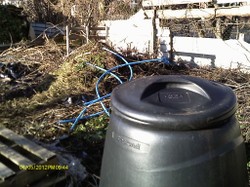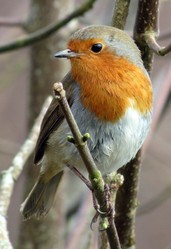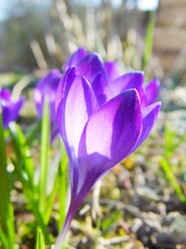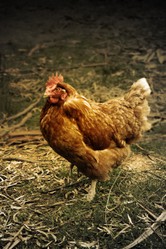In a previous wizzley article I mentioned that I had taken over an extra plot to meet the added demand for vegetables within my extended family. This is like stepping back twenty years or more to the time when I began my first allotment plot. I have had three plots, the first being a half plot that I gave up to move to a full one on another site. That was hard work, as it had been neglected for some years. So now twenty one years on I have taken on another.So what is it like beginning again?

A New Piece of Land
by frankbeswick
What it is like to take over a second plot and begin again from scratch, well nearly anyway.
Hitting Hard Pan
The council, heavily strapped for cash,like all UK councils constrained by government parsimony, has jacked up allotment rents to a level that they call sustainability. This is not what green activists call sustainability, but financial sustainability,meaning that the land must pay its way. I don't blame them, it is not their fault, nothing that a new government would not cure, but that's not on the cards at present, though we live in hope. But several plots on our allotment came available as people left, and there was added demand on my existing plot, which I am keeping as well, so I took an extra half plot. I have said before on Wizzley that the land was tilled by a pleasant couple, but that it was not worked well and is in need of some tender loving care.
Andrew came down to help with the digging, and the land needed it; and I needed his help. OK, I could have dug it over myself, but extra [young] muscle is much appreciated. I tell his Irish grandmother that he digs like an Irishman, and she loves it! He is one of my children who has always appreciated his Irish heritage. He tells me that doing this task takes him back to the 1990s, when he as a fifteen year old helped me clear my first allotment plot on another site.Yes, I thought, it does take us back, but it makes me think of the passage of time;and that is a bit sobering.
We have done the digging well, but in doing so we have a hit a bit of a problem, not one that is insurmountable, but one that requires hard work: hard pan! What's this, you ask? Well, when ground has been dug only to a certain depth for many years the soil stratum immediately below it can become rock hard, and this is what has happened to a certain degree. I cannot easily dig more than a spade's depth. But there is a tool that will handle the job,a mattock. Think of an ax and rotate the blade so that it is ninety degrees to the stem, curve it a bit, and you have a mattock. It has something of an pick blade on the other side of the head. Think power,for a mattock is heavy and capable of beating its way into heavy and hard ground. It is on order at the moment and due in a day or two's time. Andrew has used one before in his days working on a tree nursery, and I am looking forward to using it.
But the soil needs some care. On that side of the allotment site it seems to have more clay than the other side does. This seems to be the residue of a stream, now culverted, that once flowed along its border, and often overflowed apparently, hence the clay that it deposited. Clay is great for plants, but needs some work. I am going to lighten it up with the addition of organic matter. I prefer pelleted chicken manure, as the improvements to the parking zone and the track that were wrought by the previous committee would be sullied by a large pile of manure being dropped on them. I would rather be popular! am also going to add some compost and lime. Why the lime? It breaks up clay soil into a smaller particles, in a process known as flocculation. I have been adding some potash with wood ash from my wood burner, which should raise the pH level slightly. Anyway, unless further problems arise, that's the soil settled.
Managing the New Plot.
Having two plots to manage makes work harder, but it is countered by the fact that I am getting more help than I used to when Andrew was living away from Manchester, but his wife wants to be in on the act, and is promising to help in the summer.
The way to do it is not to replicate exactly on the new plot what you are doing on the first plot. Nor do you want to treat the new garden as merely an appendage to the larger, full one. So the technique is to treat them as complementary to each other. So what will I be doing on my main plot? Well, firstly I am developing a herb garden across the front, and behind that in the coming year there will be three beds planted in succession for salads. There is a second greenhouse, and so I can now grow a larger range of tomatoes, eggplants,cucumbers and greenhouse vegetables. I am planning some sweet corn and as a novelty for my Portuguese daughter-in-law sweet potatoes to be grown in one of the raised beds.
But what any garden needs is an area where you concentrate on bulk crops. In Victorian walled home gardens, which were attached to great estates such as Heligan, they often had an extra area outside the walls for crops that were needed in large quantities. These include potatoes, onions and leeks and in my case beans, as I can find an outlet for these with my vegetarian daughter-in-law, though we eat but few of them.
There is a small plum tree in the middle of the plot, but I am not impressed with its quality, for it is weedy and undersized,possibly due to poor soil fertility, and it is far behind my luxuriant plum on the main plot. I am undecided on its future and will await the fruiting later in the year. Andrew wants to retain it, I think, but we will see.
There is also an axing job to be done on the rickety compost bins at the rear, as they are likely to fall to pieces if I touch them. Fortunately, I have a large felling ax designed for bringing down trees, so I can take it to the decaying timbers, which will not take long to break up. But there are rules for ax safety that must be followed. I keep this tool at home to prevent its falling into the hands of burglars, who sometime raid garden and allotment sites for electrical tools. They would not want the ax, but they could use it to smash into a shed. Furthermore, you should not use a felling ax without wearing strong boots. I have seen celebrities on television in gardening shows pick up an ax in the wrong way, holding it loosely by the bottom of the handle, whereupon I annoy family members by calling out, "Hold it properly!" The celebrities cannot hear, but my response is second nature to me. Axes should be held firmly just under the head. The danger? If you drop one on your foot you can sever an artery. Death has resulted in some cases.
Reflections
As the new year, 2017, begins, I feel that I am moving on in my gardening journey. I am shrinking my business interests to an end in this coming June and have no desire to return to the education system in which I once worked. I am retaining some examination work for extra cash, but the goal is for gardening to more fully become one of the two pillars of my ideal way of life, which are gardening and writing.
I must admit that I was daunted at first by the thought of the extra work involved in preparing a plot again, but also excited, as it took me back to the time when I began my first allotment plot. That was not the first time that I had gardened, for I grew some vegetables at home for many years, but it was a step up. The extra plot is my stepping up again,turning vegetable and fruit growing into a more absorbing part of my life. It has been nineteen months since I did my last day in a school, and there will be no more of them. I want to finalize the transition in my way of life to make the peaceful and productive future that I want.
Today,2cnd January,is cold and frosty, and the ground is too icy to be easily dug, so I await the arrival of the mattock and have taken the day off gardening.But the seasons swing round, as they ever do, and the days are lengthening. On the morrow I hope to go and do the jobs that need doing. One thing I hope is that the robin, a female to judge from her light browny-red breast, who follows my digging on the main plot will fly over and do as she has ever done, watch the dug ground for worms and insects. I cannot send her an invitation, but I will be glad of her presence, a sign of the persistence of life in the depth of winter. I suppose that it is not one single robin, for the first who visited will now have died, and what I see is her descendants, but symbolically she is the archetypal robin, a flash of colour in the dullness of winter. Though she never lets me near her, she is an old friend who is always welcome.
You might also like
Gardening in the PandemicDespite all the deaths of people the garden goes on as a sign of hope and bet...
Late Winter in the GardenThe are joys of the first intimations of Spring, but they are marred by frust...
Much in Little: food production in a small spaceSome pioneering market gardeners and farmers are reviving small scale market ...







 Pilgrimage. A review26 days ago
Pilgrimage. A review26 days ago
 Leo the Fourteenthon 05/09/2025
Leo the Fourteenthon 05/09/2025
 The Melsonby Hoardon 03/25/2025
The Melsonby Hoardon 03/25/2025




Comments
Thank you for your comment below in answer to my previous observation and question.
Business- and government-owned lands must be managed as non-private lands.
What would church- and royal-owned lands be managed as?
Both. The Mesozoic beds ofbchalk ,politic limestone and certain marks and sandstone cover much of south eastern England.
Thank you for your comment below in answer to my previous observation and question.
Is southern England's fossilized, Jurassic-deposited manure on non-private and private lands?
South Eastern England has much chalk, which is a cretaceous deposit, and at places the rock is exposed. With the landowner's permission a fossil can be chipped out of the rock in any places not specifically protected.
Thank you for your comment below in answer to my previous observation and question.
Farmers applying fossilized manure impresses me as an environment-friendly practice even as it puzzles me somewhat as to its unrestricted accessibility.
Is a fossil or something Jurassic -- even manure, not body parts -- not indicated as an off-limits archaeological site?
It is. cheaper to buy fertiliser, but there is no objection to the practice resuming.
Thank you for your comment below in answer to my previous observation and question.
The practice stopping intrigues me.
Might other farm-soil health- and remediation-friendly sources have become available in closer and more convenient and seemingly effectiver ways?
Not now, but the practice could return
Thank you for your comment below in answer to my previous observation and question.
The dinosaur manure from Southern England's Jurassic deposits intrigues me.
Is it an ongoing practice to involve such manure in modern farm-soil health and remediation?
Yes. Most, if not all, bird manure is good for soil. You have heard of guano, which is solid bird manure dug out ofbthe ground. English farmers used to use fossilizedvdinosaur dingbat manure. This was dug out of Jurassicbdepositsvin Southern England